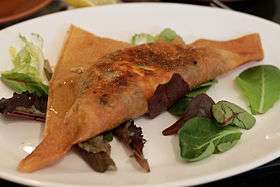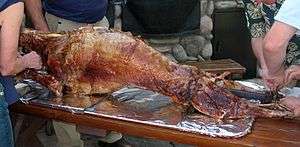Maghreb cuisine
Maghreb cuisine is the cooking of the Maghreb region, the northwesternmost part of Africa along the Mediterranean Sea, consisting of the countries of Algeria, Libya, Morocco, and Tunisia. The region has a high degree of geographic, political, social, economic and cultural diversity which influences its cuisine and culinary style.
Well-known dishes from the region include couscous, pastilla, and the Moroccan tajine stew.
Origins
.svg.png)
The cuisine of the Maghreb, the western region of North Africa that includes the five countries of Morocco, Algeria, Tunisia, Libya, and Mauritania, has been influenced by Andalusian, Phoenician and Berber dishes. The cuisines of Algeria and Tunisia have in addition been influenced by French and Italian cuisine respectively. Moroccan cuisine has its origins in the cuisines of the kingdom of Numidia in modern-day Algeria and the kingdom of Mauretania in modern-day Morocco.
Cuisine
In North African cuisine, the most common staple foods are wheat (for khobz bread[1] and couscous[2]),[3] fish, seafood, goat,[4] lamb,[4] beef,[4] dates, almonds, olives and various vegetables and fruits. Because the region is predominantly Muslim, halal meats are usually eaten. Most dishes are spiced,[5] especially with cumin,[6] ginger, paprika, cinnamon[6] and saffron. Fresh peppermint, parsley, or coriander are also very common. Spice mixtures such as ras el hanout, baharat, and chili pastes like harissa (especially in Tunisia) are frequently used. The use of legumes, nuts, fruits and spices is very prominent.[4] Salt-preserved lemons (l'hamd mrakad) and so-called "oil-cured" olives are distinctive elements of the cuisine.[3]
The best-known North African dish abroad is couscous,[7] made from wheat semolina.[5] The tajine, a cooking vessel made of clay of Berber origin, is also a common denominator in this region, although the dishes and preparation methods vary widely. For example, a tajine in Tunisia is a baked frittata/quiche-like dish,[8] whereas in Morocco it is a slow-cooked stew.[9] Pastilla is also an important Arab-Andalusian dish of North Africa.[10]
 Brik with egg, tuna, onion and parsley
Brik with egg, tuna, onion and parsley Méchoui, a whole sheep, spit-roasted
Méchoui, a whole sheep, spit-roasted Shakshouka with egg
Shakshouka with egg Pastilla with meat
Pastilla with meat Bread, baked the traditional way
Bread, baked the traditional way.jpg) Moroccan tagine with bread and mint tea
Moroccan tagine with bread and mint tea
See also
References
- ↑ Qarooni, Jalal (1996). Flat Bread Technology. Springer. pp. 84–. ISBN 978-0-412-08111-8.
- ↑ Smith, Andrew (2013). The Oxford Encyclopedia of Food and Drink in America. Oxford University Press. pp. 567–. ISBN 978-0-19-973496-2.
- 1 2 MacVeigh, Jeremy (2008). International Cuisine. Cengage Learning. pp. 273–. ISBN 1-111-79970-9.
- 1 2 3 4 "North African Cuisine." Jamaica Observer. Accessed June 2011.
- 1 2 Mourad, Mazouz. "The Momo Cookbook." The Globalist. Accessed June 2011.
- 1 2 "Organic Cooking: North African Cuisine." Organicauthority.com. Accessed June 2011.
- ↑ Cheshes, Jay (12 November 2012). "Couscous Royale". Saveur. Retrieved 3 October 2016.
North Africa's best-known dish has become one of the most widely consumed foods in France. These days, even ordinary neighborhood bistros often feature a couscous special one day of the week.
- ↑ "Tunisian Tagine". BBC. Retrieved 3 October 2016.
- ↑ Cloake, Felicity (13 March 2013). "How to make the perfect chicken tagine". The Guardian. Retrieved 3 October 2016.
Does this most famous of all Moroccan dishes actually need to be cooked in a real tagine?
- ↑ Best, Cassie. "Chicken & almond pastillas". BBC. Retrieved 3 October 2016.
External links
| Wikivoyage has a travel guide for North African cuisine. |